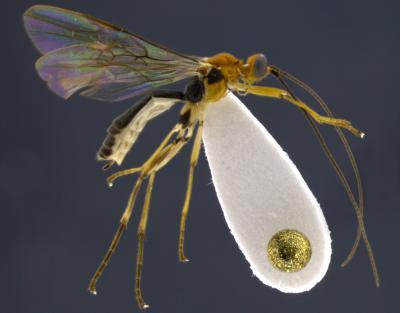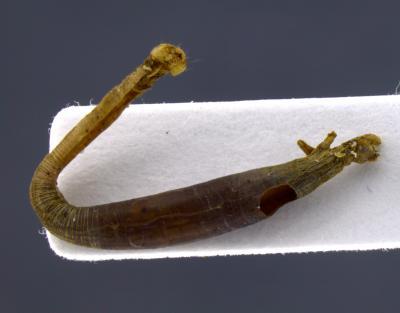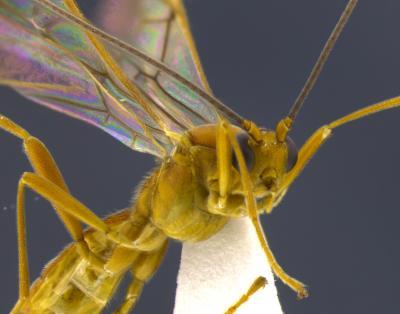Some Ecuadorian tribes were famous for making mummified shrunken heads (click for the recipe) from the remains of their conquered foes.
Perhaps they got the idea from nature. Field work in the cloud forests of Ecuador has resulted in the discovery of 24 new species of Aleiodes wasps - that mummify caterpillars. 24 new insect are species described by Eduardo Shimbori and Scott Shaw in ZooKeys and they don't mind glorifying celebrities in the naming.
One wasp causes its host caterpillar to bend and twist in an unusual way so the authors did their own twisting and decided that needed to be named after pop singer Shakira.

Aleiodes shakirae, the Shakira wasp The golden dot on the lower right is the head of a pin. Credit: Eduardo Shimbori
Others who got honored were Jimmy Fallon, Jon Stewart, Stephen Colbert, and Ellen DeGeneres, as well as the Ecuadorian artist Eduardo Kingman and American poet Robert Frost.
"These wasps are very small organisms, being only 4 to 9 millimeters long, but they have an enormous impact on forest ecology," Shaw said. Aleiodes wasps are parasites of forest caterpillars. The female wasps search for a particular kind of caterpillar, and inject an egg into it. Parasitism by the wasp does not immediately kill the caterpillar, but it continues to feed and grow for a time. Eventually, feeding by the wasp larva causes the host caterpillar to shrink and mummify, then the immature wasp makes its cocoon inside the mummified remains of its conquered prey.
When it completes its development, the young wasp cuts an exit hole from the caterpillar mummy and flies away to mate, and continue this cycle of parasitic behavior. "Killing and mummifying caterpillars may sound bad, but these are actually highly beneficial insects," Shaw says. "These wasps are helping to naturally control the populations of plant-feeding caterpillars, so they help to sustain the biodiversity of tropical forests."

A mummified host caterpillar with abdominal bending, parasitized by the Shakira wasp. Credit: Eduardo Shimbori
The field research was conducted by Shaw at the Yanayacu cloud forest research station of Napo Province, in the eastern Andes slopes of Ecuador. Previous research by Shaw had discovered nine species of mummy-making wasps at the site, and others are known from around the world, but the full extent of these insect's biodiversity in Ecuador did not become apparent until recently, when Shimbori and Shaw collaborated to name them all.

Hey, why am I way down at the bottom? Right, most scientists are men. The Shakira thing makes sense now. Aleiodes falloni, the Jimmy Fallon wasp Credit: Eduardo Shimbori
The research was supported by a grant from the National Science Foundation, called Caterpillars and Parasitoids of the Eastern Andes.





Comments